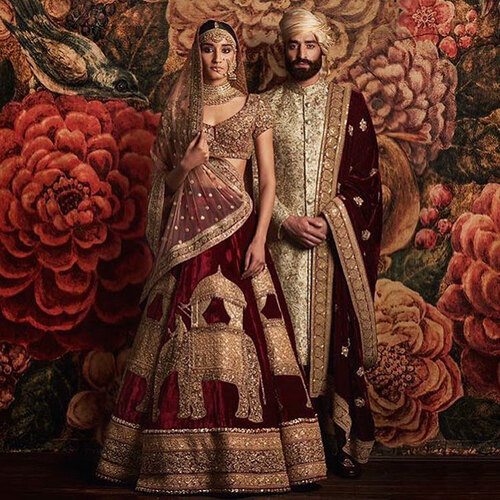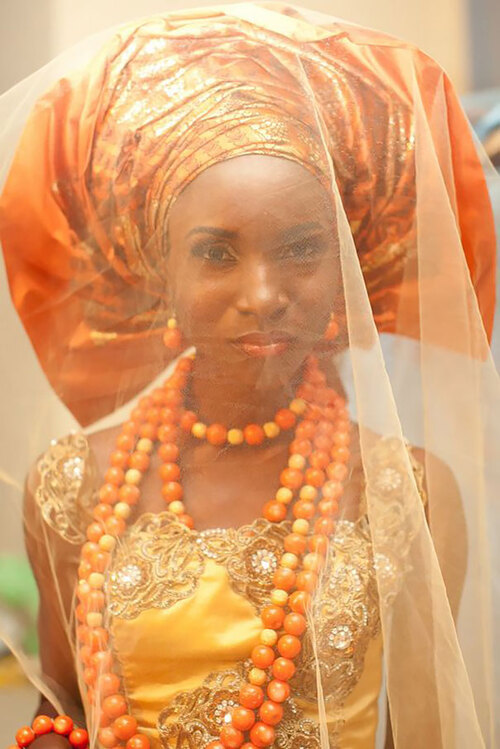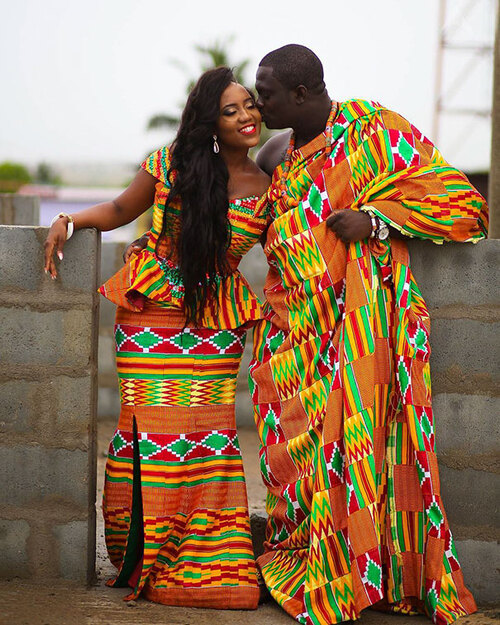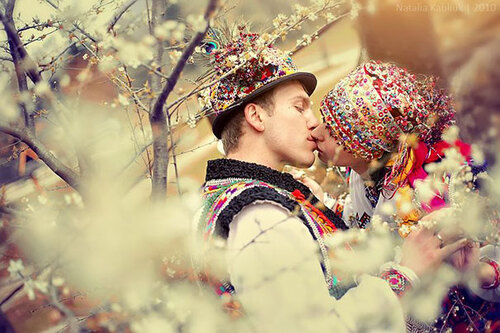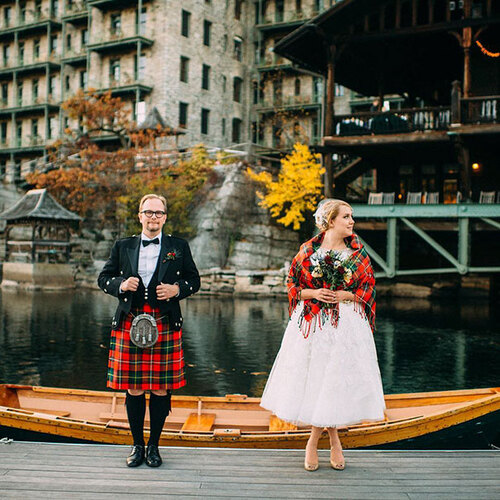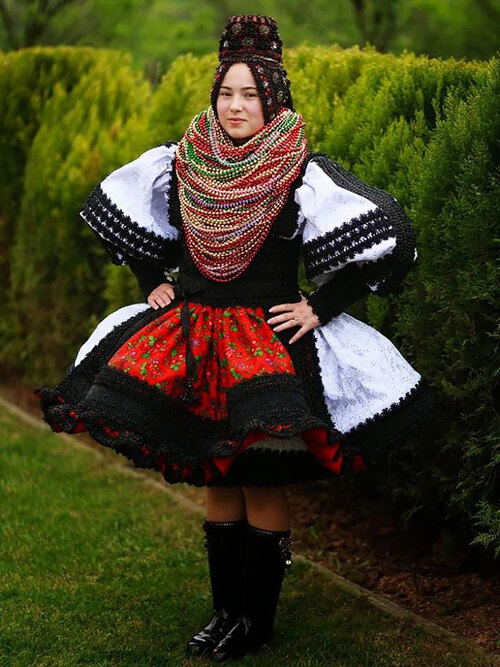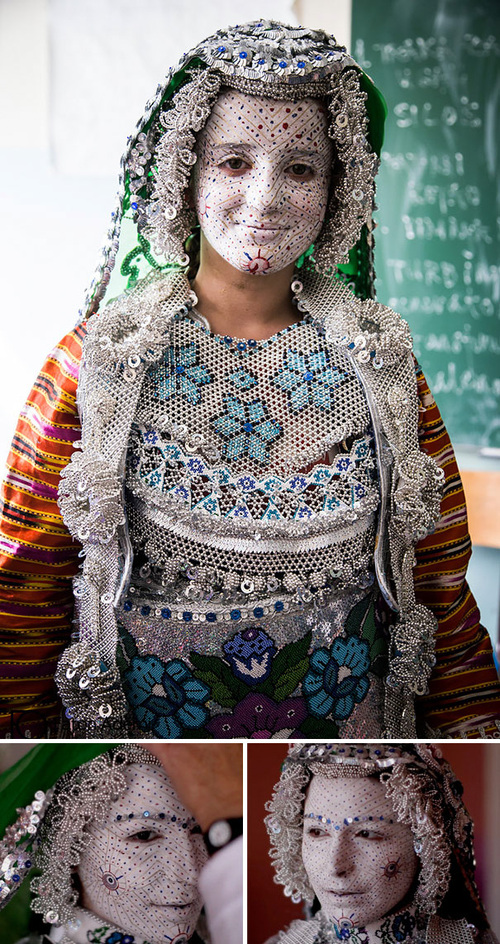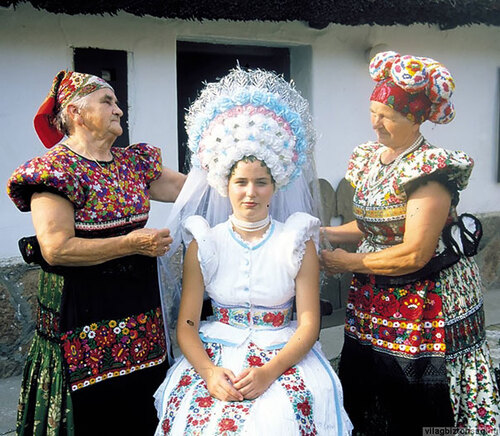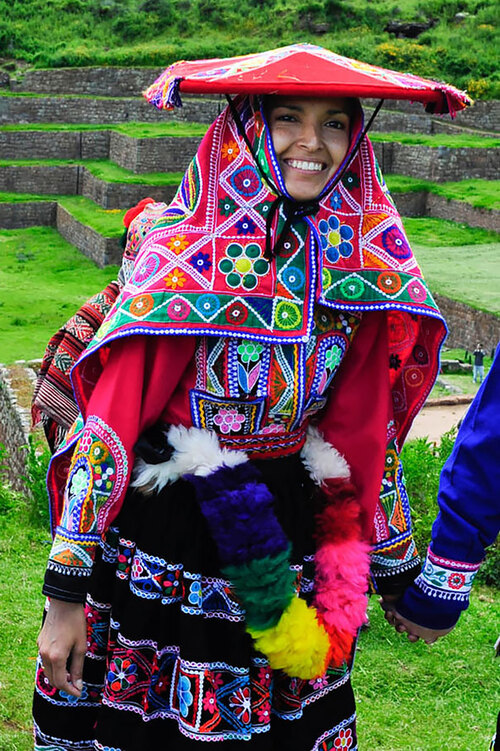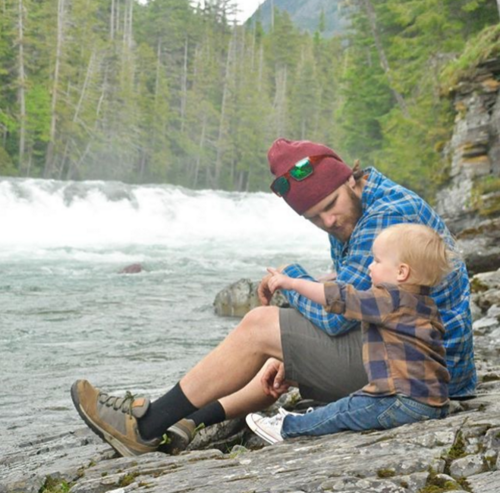-
Par GUETTEURNORDIQUE le 24 Juillet 2016 à 12:42
In western cultures, brides traditionally wear a white dress on their wedding day. Look beyond the west however and you'll find a wide variety of wedding attire according to different countries and cultures. Some brides adorn themselves in colorful garments, others paint their hands and faces in accordance with local traditions, and some hide their faces completely behind layers of jewelry or veils.
Not everybody upholds these traditions of course, and many people wear what they want for their Big Day, but this list compiled by Bored Panda provides an interesting insight into the different ways that different people can celebrate the same occasion. Who knows, maybe you'll find some inspiration!
1 Indian Wedding:
In Indian culture, pink or red wedding dresses are often the garment of choice for brides. Married woman in the north of the country can often be identified by a red dot in the middle of their forehead.
That "red dot" is called a Bindi.
2 Nigerian Bride:
Nigeria is a big country with around 250 ethnic groups and over 500 languages. Wedding ceremonies therefore change according to region, religion and ethnic background. However, Nigerian brides often wear brightly colored wedding clothes. They also often wear a Nigerian head tie called a Gele.
3 Traditional Wedding In Ghana:
Traditional weddings in Ghana are often very colorful, and each family has its own cloth pattern that features on the bride and groom's wedding outfits.
So colourful! What a beautiful couple!
4 Hutsuls Wedding In Ukrainian Carpathians:
The Hutsuls are an ethno-cultural group of Ukrainians who have lived for centuries in the Carpathian Mountains. The traditional wedding clothes are very colorful and the weddings themselves are very lively and full of dancing, games and jokes.
The man's hat is fascinating.
5 Kazakhstani Bride:
In a traditional Kazakh wedding, brides typically wear a headdress known as a "Saukele" as well as a facial veil. The Saukele is usually prepared long before the girls reach the age of marriage.
Looks like a princess.
6 Mongolian Bride:
In a traditional Mongolian wedding ceremony, the bride and the groom each wear what's known as a Deel. A Deel is a form of patterned clothing that's been worn for centuries by Mongols and other nomadic tribes in Central Asia.
Interesting indeed.
7 Japanese Wedding:
For a traditional Japanese wedding, the bride often wears a pure white kimono for the formal ceremony, which symbolizes purity and maidenhood. After the ceremony the bride may then change into a red kimono to symbolize good luck.
Stunning kimono.
8 Scottish Wedding:
Men in Scotland traditionally wear the kilt of his clan for his wedding. After the ceremony, the bride wears a shawl emblazoned with her new husband's clan colors to signify her transition into his family.
This is in upstate New York.
9 Romanian Bride From Oas Region:
Weddings in Oas are an important event in the north-west part of Transylvania. The wedding is organized by the parents as well as the bride-and-groom-to-be and various different rituals are involved including the preparation of the dowry and the costumes, choosing the godparents, and preparing the wedding flag.
I like the skirt / boot combo.
10 Chinese Wedding:
In China the colour red is considered to symbolize good luck. The colour is also believed to keep away evil spirits. It's therefore no surprise that traditional Chinese wedding outfits almost always feature the colour red.
Love the colors.
11 Bride In Gora Region Between Kosovo And Macedonia:
The Gorani people are Muslims by faith, but their traditions and customs contain various pagan elements. The bride is carried on a white horse covered with a scarf and a specially decorated umbrella during wedding festivities, and she accompanies her family to the neighbour's house of her husband-to-be.
She looks just like a carefully crafted porcelain doll. How stunning.
12 Yakan Bride:
The Yakan are an ethno-linguistic group that mostly inhabit the island of Basilan in the Philippines. Traditional weddings usually consist of two ceremonies, an Islamic one and an older, pre-Islamic ritual. The weddings are arranged by the parents and both the bride and groom wear face paint for the ceremony.
Stunning and so elegant.
13 Matyo Bride From Hungary:
In traditional Hungarian weddings, a brides attire usually includes an embroidered dress with floral patterns and three bright colors. She often wears many underskirts as well as an elaborate head-dress with wheat woven into it.
Love the other women´s outfits too.
14 Traditional Wedding Costumes And Bridal Crown From Norway:
In Norway, the traditional wedding costume is called a Bunad. It can also be worn for other occasions such as christening parties.
They look pretty happy :)
15 Traditional Peruvian Bride In Sacred Valley Near Cuzco, Peru:
Traditional Andean wedding outfits are often bright and include woven cloaks and hats adorned with tassels and reflective material. A special skirt and poncho is made for the bride and groom's wedding day.
 votre commentaire
votre commentaire
-
-
Par GUETTEURNORDIQUE le 23 Juillet 2016 à 12:33
Answer: To convert is to be “born again.” At the moment of conversion, the converted person is filled with the Holy Spirit and begins a journey of turning away from sin and beginning to worship and serve the Lord. A “false conversion” is no conversion at all. A false conversion may look like a true, Spirit-caused conversion, but it is not. The reasons for false conversions are varied. Sometimes the person experiencing a false conversion doesn’t even realize it. At other times, there is intentional deception on his/her part. Not everyone who claims to have been converted has, in fact, been converted.
Just as those trained to recognize counterfeit money become intimately acquainted with the real thing, in order to detect a false conversion, it is necessary to first know what true Christian behavior looks like. We do this by studying and knowing intimately God’s Word. We learn from the Parable of the Weeds in Matthew 13:24–30 that Satan works to deceive the church by mingling his children with God’s children, often making it difficult for believers to discern the true from the false. The more we are familiar with Scripture, the easier it will be for us to detect the true Christians from the false converts.
True Christians are “born again” (John 3:3) and are controlled by the Holy Spirit; they are no longer controlled by their sinful nature (Romans 8:9). Indeed, born-again Christians have the Spirit of Christ indwelling their hearts (Galatians 4:6), and they become new creations: “The old has gone, the new has come!” (2 Corinthians 5:17). When a person receives Christ, tremendous spiritual changes take place in him, and true converts will indeed display the characteristics of genuine Christians. For example, true Christians will understand the importance of abiding daily in God’s Word, which shows not only how we can be saved from our sins, but also how we may be equipped to serve God and how to obtain true success in life (2 Timothy 3:17; James 1:25). True Christians will walk in the light and obey God’s commands, for “God’s love is truly made complete” in those who obey His Word (1 John 2:5).
Christians live by the Spirit so as not to gratify the desires of the sinful nature, “for the sinful nature desires what is contrary to the Spirit and the Spirit what is contrary to the sinful nature” (Galatians 5:17). The things of this world, “the cravings of sinful man, the lust of his eyes and the boasting of what he has and does” (1 John 2:16) no longer have a stronghold on the life of the true believer. Indeed, “those who belong to Christ Jesus have crucified the sinful nature with its passions and desires” (Galatians 5:24). We no longer live for us; rather, we live for the One who died for us, sacrificing our desires and ambitions and replacing them with those of Christ. Granted, we will never be completely victorious in our Christian walk (1 John 1:8); however, Christians will not repeatedly engage in sinful behavior, as “no one who is born of God will continue to sin, because God’s seed [nature] remains in him” (1 John 3:9). And this new nature exhibits the habitual character of righteousness produced by the Holy Spirit (Galatians 5:22–23).
In Matthew 7:13–14 Christ tells His followers the road that leads to eternal life is narrow and that “only a few find it.” The broad road with the wide gate, on the other hand, is the one that leads to destruction, and we see that “many” will take this path. And many who claim to be converted Christians will never leave the broad road with its worldly allurements. They desire to live an easy Christianity that makes few demands on them, yet when “trouble or persecution comes because of the word” they quickly fall away (Matthew 13:21). Furthermore, they produce little, if any, fruit. Yet we know that true faith in Christ profoundly changes one’s life and will cause us to produce much fruit for God’s glory. And, ultimately, fruit is the test of true salvation, and this includes holiness (Romans 6:22), Christian character (Galatians 5:22–23), good works (Colossians 1:10), winning others to Christ (Romans 1:13), sharing what we have (Romans 15:25–28; Hebrews 13:16), and praising God (Hebrews 13:15). As Christ said, “By their fruit you will recognize them. . . . A good tree cannot bear bad fruit and a bad tree cannot bear good fruit” (Matthew 7:16, 18).
Truly converted sinners have trusted Christ alone and seek to become more and more Christ like all the time. Those who claim to be Christians should display the characteristics of true Christians: sound doctrine, obedience to God’s Word, and love. They should unashamedly work to spread the good news of the gospel, as we are called to do (Matthew 28:19–20), knowing well that they might be mocked and ridiculed by many in these increasingly secular times. And although false Christians may sometimes be able to deceive us, they certainly cannot deceive God, as nothing in all creation is hidden from His sight. Everything is uncovered and laid bare before the eyes of Him to whom we must give account (Hebrews 4:13). At the end of the age, His angels will separate the true from the false Christians.
http://www.gotquestions.org/false-conversion.html votre commentaire
votre commentaire
-
-
Par GUETTEURNORDIQUE le 22 Juillet 2016 à 09:22
Camping With Kids: Everything You Need to Know.
Instagram
Outdoorsy types will attest that there's nothing better than a family camping adventure--loads of free time, no screens and green as far as the eye can see. Camping can be a family-friendly bonding activity for kids of all ages. But how do you make your trip to the Great Outdoors fun, safe and kid-friendly? We'll share our pro tips to make your next family camping trip amazing.
Make a Plan!
Before you pack up the tents and fill your canteens, you'll need to pick a campsite location. If you're a seasoned camper, then you may need to downplay your own expectations for what your kids can handle. Depending on their ages, they may not be up for long hikes to the campsite or carrying heavy packs with gear.
Some campsites offer basic amenities such as bathrooms and showers, whereas some camping spots are just a patch of dirt for your tents. For your first camping trip with the family, pro rangers suggest that you might be more comfortable with modern amenities--bathrooms, running water and a place to change.
Gear Up!
Once your family has picked out the right campsite, it's time to start prepping for your trip. The first step will be assembling the gear you'll need. What do you really need? It depends on how well stocked or remote your campsite is.
At a minimum, you're going to need a family tent and a backpack for each family member. Of course, you'll also need clothes, food, toiletries and medications for each person. For babies, you'll need the comforts of home--diapers, wipes, bottles, a sleeping space, etc.
Long gone are the days of restless nights and neck or back pain in the morning. Modern tents and sleeping pads can provide a level of comfort almost equivalent to your bed at home. For a family of four or more, look for a tent that can accommodate all of you.
Pro tip: Know that spending a little more on quality gear can keep you dry and toasty, so don't skimp on the big purchases. Two doors on the tent means that nobody gets feet in their face while others are coming and going. And a rain-coverage fly helps repel water and bugs.
Pack Up!
Make a list and stick to it. List all the necessities, and then cross off items as you add them to your gear. Having a list means that you won't forget essentials or overpack.
Remember that you're going to be carrying these packs through the woods, so don't stuff them or your back will regret it. Include garbage bags for each family member to make the chore of returning with damp, muddy clothing and shoes less offensive.
For a terrific resource on packing lists for kids, check out wildernessforkids.com. Their downloadable, customizable forms can keep your family organized and on track.
Pro Tip: Older kids can help prep for the trip. Simply hand them their own lists and then put them in charge of getting together their own gear and clothes. Of course, double-check before you head out to make sure the kids packed what they need.
Plan Meals!Some families like to fish out of the river and cook what they catch. Other families want to know that their campsite is within an hour of local sushi delivery. Figure out what your family's meal expectations and dietary needs are, and then plan accordingly.
Prepping dinner over an open flame is fun, just keep it simple. The good news is that most developed campgrounds provide either a grill or a fire pit at each site. This means you won't need to drag along a special (heavy!) camping stove or any special cookware. All you need is a roll of aluminum foil and some basic cooking utensils, and you're a wilderness chef.
Pro tip: If your site doesn't provide a grill, simply bring an oven rack from home to use over the fire pit. Prop the rack on top of the fire pit and use it as a makeshift grill top. At home, wash it and then put it back in your stove.
Have Fun!
Any seasoned parent will tell you that part of traveling with kids is learning to roll with it. Your goals should be to bask in nature and sleep under the stars--that's all you need for a memorable camping experience.Plan to let the kids tell you what they want to do, rather than planning a schedule full of long hikes, structured sight-seeing and elaborate meals. Your kids will just be happy to be there, with you, in the outdoors! There are no schedules or commitments out in the woods, so enjoy the down time.
Pro Tip: Breathe in the fresh air and simply be. You're there to spend time as a family, together.
Family camping is a magical, inexpensive way to create lifelong memories with your kids. The Great Outdoors beckons your family to plan an epic trip you'll cherish. What are you waiting for? (By Katie Morton).
 votre commentaire
votre commentaire Suivre le flux RSS des articles de cette rubrique
Suivre le flux RSS des articles de cette rubrique Suivre le flux RSS des commentaires de cette rubrique
Suivre le flux RSS des commentaires de cette rubrique
